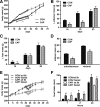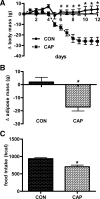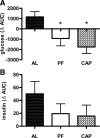The effect of angiotensin-converting enzyme inhibition using captopril on energy balance and glucose homeostasis
- PMID: 19497971
- PMCID: PMC2736089
- DOI: 10.1210/en.2009-0065
The effect of angiotensin-converting enzyme inhibition using captopril on energy balance and glucose homeostasis
Abstract
Increasing evidence suggests that the renin-angiotensin-system contributes to the etiology of obesity. To evaluate the role of the renin-angiotensin-system in energy and glucose homeostasis, we examined body weight and composition, food intake, and glucose tolerance in rats given the angiotensin-converting enzyme inhibitor, captopril ( approximately 40 mg/kg . d). Rats given captopril weighed less than controls when fed a high-fat diet (369.3 +/- 8.0 vs. 441.7 +/- 8.5 g after 35 d; P < 0.001) or low-fat chow (320.1 +/- 4.9 vs. 339.8 +/- 5.1 g after 21 d; P < 0.0001). This difference was attributable to reductions in adipose mass gained on high-fat (23.8 +/- 2.0 vs. 65.12 +/- 8.4 g after 35 d; P < 0.0001) and low-fat diets (12.2 +/- 0.7 vs. 17.3 +/- 1.3 g after 21 d; P < 0.001). Rats given captopril ate significantly less [3110.3 +/- 57.8 vs. 3592.4 +/- 88.8 kcal (cumulative 35 d high fat diet intake); P < 0.001] despite increased in neuropeptide-Y mRNA expression in the arcuate nucleus of the hypothalamus and had improved glucose tolerance compared with free-fed controls. Comparisons with pair-fed controls indicated that decreases in diet-induced weight gain and adiposity and improved glucose tolerance were due, primarily, to decreased food intake. To determine whether captopril caused animals to defend a lower body weight, animals in both groups were fasted for 24 h and subsequently restricted to 20% of their intake for 2 d. When free food was returned, captopril and control rats returned to their respective body weights and elicited comparable hyperphagic responses. These results suggest that angiotensin-converting enzyme inhibition protects against the development of diet-induced obesity and glucose intolerance.
Figures






References
-
- Woods SC, Seeley RJ, Porte Jr D, Schwartz MW 1998 Signals that regulate food intake and energy homeostasis. Science 280:1378–1383 - PubMed
-
- Schwartz MW, Woods SC, Porte Jr D, Seeley RJ, Baskin DG 2000 Central nervous system control of food intake. Nature 404:661–671 - PubMed
-
- Ogden CL, Carroll MD, Curtin LR, McDowell MA, Tabak CJ, Flegal KM 2006 Prevalence of overweight and obesity in the United States, 1999–2004. JAMA 295:1549–1555 - PubMed
-
- Massiera F, Seydoux J, Geloen A, Quignard-Boulange A, Turban S, Saint-Marc P, Fukamizu A, Negrel R, Ailhaud G, Teboul M 2001 Angiotensinogen-deficient mice exhibit impairment of diet-induced weight gain with alteration in adipose tissue development and increased locomotor activity. Endocrinology 142:5220–5225 - PubMed
-
- Weisinger RS, Begg DP, Chen N, Jois M, Mathai ML, Sinclair AJ 2007 The problem of obesity: is there a role for antagonists of the renin-angiotensin system? Asia Pac J Clin Nutr 16:359–367 - PubMed
Publication types
MeSH terms
Substances
Grants and funding
LinkOut - more resources
Full Text Sources
Research Materials

